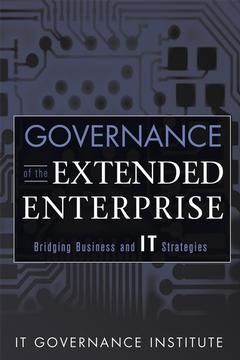Description
Governance of the Extended Enterprise
Bridging Business and IT Strategies
Author: IT Governance Institute
Language: English
Subject for Governance of the Extended Enterprise:
Keywords
structure; governance; discover; extended; implement; effective; enterprise; success; longterm; element; strategy; key; business; explores; worlds; integrated; technology; enterprises; information
224 p. · 16x24 cm · Hardback
Description
/li>Contents
/li>Biography
/li>
IT is no longer an enabler of corporate strategy, it is now the key element of corporate strategy. Governance of the Extended Enterprise explores how some of the world's most successful enterprises have integrated information technology with business strategies, culture, and ethics to optimize information value, attain business objectives, and capitalize on technologies in highly competitive environments.
Providing a process for change and a governance model, Governance of the Extended Enterprise encompasses the latest emerging practices from major information and knowledge businesses, providing a major new knowledge resource for enterprises. It also opens up new avenues of practice in strategy setting, enterprise management, control assessment, and risk management.
From sales-force automation to workgroup collaboration, forms processing to knowledge management systems, customer service to technical support, Governance of the Extended Enterprise will help readers improve IT governance in all facets of their organization.
Preface.
Introduction.
Managing Change as a Business Process.
How Do We Get There from Here?
Vision/Leadership.
Value Creation and Performance Management.
Governance Framework and Criteria.
Governance Officer.
Enterprise Architecture: Framework and Implementation.
Reference Works.
Looking Forward.
1. Extended Enterprises.
Change Agents in the Extended Enterprise Environment.
Paradigm Shift in the Business Environment/Changes in Processes.
2. Strategy: Challenge for the Extended Enterprise.
Business Strategy Challenge.
New Enterprise Risk Management Structures.
New Regulatory Compliance Challenge.
Developing Strategy with Value Innovation.
Transforming Internal Governance Strategy.
New Internal Governance Challenge.
Governance Challenge.
Bridging the Gap between the Information Technology Organization and Internal Clients.
Making Strategy a Continual Process: Coevolving and Patching.
Managing Knowledge for Better Communication: Knowledge Management.
Sharing Knowledge through a Knowledge Portal.
3. Value Creation and Management of Performance in the Extended Enterprise.
Vision and Mission.
Value Creation and Strategy Implications.
Necessity of a Core Repository of Knowledge Portal.
Suggested Architecture for Performance Measurement.
Delegate and Empower through Performance Management.
Framework for Measurement.
Control Objectives for Information and Related Technology.
Monitoring: Measuring and Comparing Outcomes for Improvements.
Ongoing Strategy Process: Operational Performance Monitoring.
4. Operational Business Activities: Value Realization for the Extended Enterprise.
Value Realization.
Blueprint for Knowledge Sharing in an Extended Enterprise.
Objectives, Goals, and Expectations.
Information and Knowledge Resources (Intangible Business Resources).
Information Sharing Activities (Two-way Communication).
Operational Business Activities.
Tangible Business Resources.
Value Creation Cycle.
5. Governance Framework for the Extended Enterprise.
Governance Definition.
Enterprise Governance Challenge in the Extended Enterprise.
Governance Structure for the Extended Enterprise.
Governance Objectives for the Extended Enterprise.
Comparison with Excellence Models.
Leadership: Driver for Values and Governance Implementation.
Maturity Levels of Leadership.
Maturity Model for Evaluating the Level of Governance of the Extended Enterprise.
Tools for the Governance of the Extended Enterprise.
6. Enterprise Architecture: Governance Implementation for the Extended Enterprise.
What Is Enterprise Architecture?
Enterprise Architecture: New Focus for Chief Information Officers.
Architecture Layers Interrelationships.
Implementing and Maintaining the Enterprise Architecture.
Information Technology Governance in the Extended Enterprise.
Strategic Alignment of IT Strategies with the Business.
IT Infrastructure to Enable Business.
Maturity Model of the Enterprise Architecture/IT Architecture.
Partner Ability for Networking/Information Flows and Relationships.
Maturity Model for IT Governance.
Establish Information Model and Data Model for Quick Implementation of a Knowledge Base.
Appendices.
A: Questions for the Board and Senior Management.
B: Performance Reference Model.
C: Organizational Structure Evolution: Core versus Central.
D: Framework and Quality Awards.
E: Business Reference Model.
F: Knowledge Work, Knowledge Management, and Knowledge Portal.
G: Enterprise Architecture Processes at Different Maturity Levels.
H: Maturity Model for Business Activities in the Extended Enterprise.
I: IT Governance.
J: IT Governance Maturity Model.
K: COBIT Information Processes.
Glossary.
References.
Other ITGI Publications.
Index.
INFORMATION SYSTEMS AUDIT AND CONTROL ASSOCIATION® (ISACA®) (www.isaca.org) is a recognized worldwide leader in IT governance, control, security, and assurance with more than 35,000 members in more than 100 countries. Founded in 1969, ISACA sponsors international conferences; publishes the Information Systems Control JournalTM; develops international information systems auditing and control standards; and administers both the globally respected Certified Information System Auditor® (CISA®) designation carried by more than 35,000 professionals since its inception, and the Certified Information Security Manager (CISMTM) designation, a groundbreaking credential earned by 5,000 professionals in its first two years.

